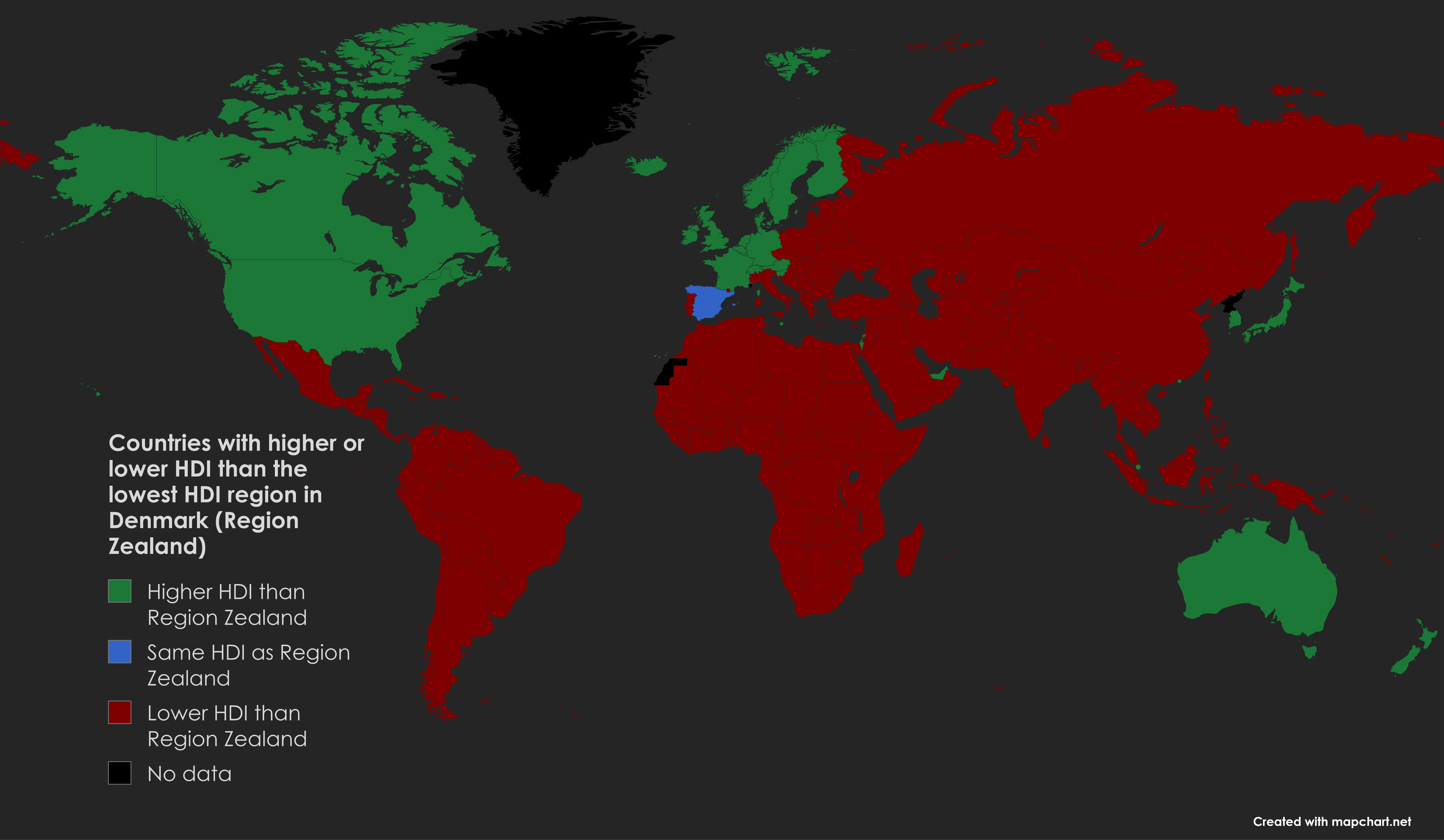HDI Comparison Map of Zealand and Other Countries


David Chen
Data Visualization Specialist
David Chen is an expert in transforming complex geographic datasets into compelling visual narratives. He combines his background in computer science ...
Geographic Analysis
What This Map Shows
The visualization titled "Countries with higher or lower HDI than Denmark's lowest HDI region (Region Zealand)" offers a compelling insight into the global landscape of human development. It allows viewers to quickly ascertain which countries rank above or below Region Zealand based on the Human Development Index (HDI). Region Zealand, which includes areas like the capital city of Copenhagen, has been noted for its relatively lower HDI compared to other parts of Denmark. This map serves as a useful tool for understanding how Denmark's development compares to other nations and highlights the disparities that exist even within a highly developed country.
Deep Dive into Human Development Index (HDI)
The Human Development Index (HDI) is a composite statistic of life expectancy, education, and per capita income indicators, which are used to rank countries into four tiers of human development. This index is essential for understanding the overall well-being of populations and the socio-economic conditions they face. Interestingly, Denmark consistently ranks highly in global HDI assessments, often landing in the top five countries worldwide. However, Region Zealand stands out as a peculiar case within this equation, showcasing a lower HDI compared to other Danish regions.
In the broader context, HDI can fluctuate significantly from one country to another. For example, countries such as Norway and Switzerland frequently top the list, exhibiting high levels of income, education, and life expectancy. Conversely, many countries in sub-Saharan Africa often have much lower HDI, driven by factors such as lower educational attainment, economic instability, and health crises.
Interestingly, Denmark's overall high standard of living contrasts sharply with Region Zealand's ranking, which can be attributed to various socio-economic factors, including income disparity and access to quality education and healthcare. The HDI for Zealand may reflect localized challenges that are not as pronounced in other regions of Denmark, making it a unique case study in human development.
Regional Analysis
When we analyze the data presented in the map, we can categorize countries based on their HDI in relation to Region Zealand's score. For instance, countries like Canada and the Netherlands have HDI scores significantly higher than Region Zealand, reflecting their robust economies and comprehensive social services. In contrast, nations such as Afghanistan and Yemen have markedly lower HDI figures, highlighting the challenges they face in terms of health, education, and income.
Examining neighboring countries, we find that Sweden and Norway also boast HDI scores that surpass Zealand, reinforcing the Nordic model's success in promoting human development. However, if we shift our focus to regions that fall below Zealand's HDI, we see a diverse range of nations marked by developmental struggles, often influenced by conflict, poverty, and systemic issues.
For example, countries like India and Brazil, which have rapidly developing economies, still show pockets of lower HDI, particularly in rural areas. This illustrates the uneven distribution of resources and opportunities within nations, where urban centers may thrive while rural regions lag behind. The map not only highlights these disparities but also emphasizes the importance of targeted policies to address such inequalities.
Significance and Impact
Understanding the HDI and its implications is crucial for policymakers, researchers, and citizens alike. The significance of this index extends beyond mere numbers; it reflects the quality of life and opportunities available to individuals. High HDI countries typically enjoy better health outcomes, higher education levels, and greater economic stability, which in turn fosters innovation and prosperity.
Conversely, countries with lower HDI face significant challenges that can inhibit growth and development. The disparities highlighted in the map prompt critical discussions about global equity and the responsibilities of wealthier nations to assist in development efforts. Moreover, as we look toward the future, trends in global development will likely continue to shift. For instance, climate change and technological advancements may impact HDI scores, altering the landscape of human development as we know it.
In conclusion, the map not only serves as a visual representation of HDI but also sparks broader conversations about social justice, economic equity, and the collective responsibility of nations to uplift those that are struggling. Understanding these dynamics is vital as we navigate an increasingly interconnected world where disparities in human development can have far-reaching consequences.
Visualization Details
- Published
- September 16, 2025
- Views
- 68
Comments
Loading comments...